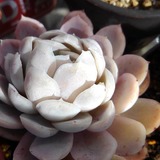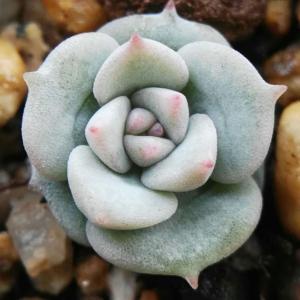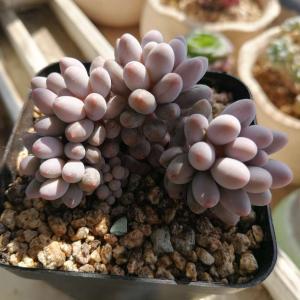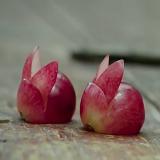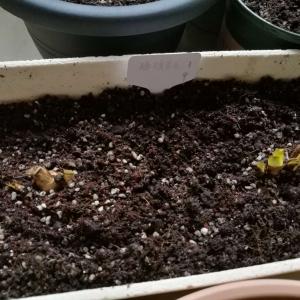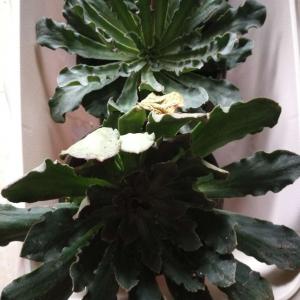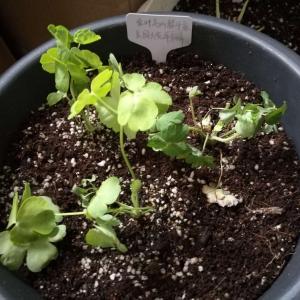成长记
Shami
2018年04月23日

These are the regular sunflower I planted 2 or 3 days after the hybrid sunflowers.


0
0
文章
Miss Chen
2018年04月23日

Description: This herbaceous perennial plant is up to 2½' tall and unbranched, except for 1 or 2 small side stems near the inflorescence. The central stem is round and glabrous, although scattered long hairs may occur where the leaves wrap around the stems, or a little below. The leaves are dark green or olive green, up to 12" long and 1" across, with parallel venation and smooth margins. They are linear to broadly linear, but wider at the base and narrowing to a pointed tip. They often bend downward toward the middle.

At the apex of the central stem or side stems, is a small cluster of violet flowers. They often droop from their slender hairy pedicels. These are subtended by two leaf-like bracts that are up to 6" long and slightly more than ½" across. Each flower is about 1" across and has 3 rounded violet petals. Toward the center, there are 6 yellow stamens and spidery violet hairs. Each flower opens up during the morning and closes during the early afternoon on sunny days, but may remain open longer on cloudy days or when it remains in the shade. There is no floral scent. The blooming period occurs from late spring to mid-summer, and lasts about 1½ months. During this time, the flowers bloom sporadically, rather than all at once. The seed capsules split open into 3 parts, each releasing 3-6 oval to oblong, brown seeds. The seeds normally fall only a short distance from the mother plant. The root system is fleshy and fibrous, producing occasional offshoots nearby.
Central Stem & Leaves
Cultivation: The preference is partial sun and moist to mesic conditions. It also tolerates light shade, and full sun if the soil is sufficiently moist. Growth is best in fertile loamy soil, but some sand or gravel is acceptable. During droughts, the tips or outer lengths of the leaves may turn yellow or brown. This plant is easy to grow and rarely troubled by foliar disease.
Range & Habitat: The native Virginia Spiderwort is fairly common in central and southern Illinois, while it is uncommon or absent in northern and extreme western Illinois (see Distribution Map). Habitats include moist to mesic black soil prairies, sand prairies, savannas, thickets, openings and edges of woodlands, sandstone cliffs, and powerline clearances through woodland areas. This plant usually doesn't stray far from areas with trees and shrubby vegetation.
Faunal Associations: Bumblebees are the most important pollinators of the flowers. Other bee visitors include honeybees, Little Carpenter bees, and Halictine bees. Syrphid flies also visit the flowers, but they feed on stray pollen and are not effective pollinators. A leaf beetle (Lema collaris) feeds on the foliage. Various herbivores eat the leaves and stems of this plant occasionally, including deer, livestock, rabbits, and the wood tortoise.
Photographic Location: The photographs were taken at Busey Woods in Urbana, Illinois.
Comments: Virginia Spiderwort can be readily distinguished from Ohio Spiderwort by the hairiness of its slender pedicels. However, hybrid plants with Virginia Spiderwort as one of the parents can escape from cultivation; they may or may not have hairy pedicels. Virginia Spiderwort also has larger bracts subtending the flowers than Ohio Spiderwort, and it tends to be shorter with stouter leaves that don't have bluish tints. White flowers can be produced by plants in the wild, but this is very rare. Other color variations are available through market hybrids. The leaves and stems are supposed to be edible – fresh or cooked.

At the apex of the central stem or side stems, is a small cluster of violet flowers. They often droop from their slender hairy pedicels. These are subtended by two leaf-like bracts that are up to 6" long and slightly more than ½" across. Each flower is about 1" across and has 3 rounded violet petals. Toward the center, there are 6 yellow stamens and spidery violet hairs. Each flower opens up during the morning and closes during the early afternoon on sunny days, but may remain open longer on cloudy days or when it remains in the shade. There is no floral scent. The blooming period occurs from late spring to mid-summer, and lasts about 1½ months. During this time, the flowers bloom sporadically, rather than all at once. The seed capsules split open into 3 parts, each releasing 3-6 oval to oblong, brown seeds. The seeds normally fall only a short distance from the mother plant. The root system is fleshy and fibrous, producing occasional offshoots nearby.
Central Stem & Leaves
Cultivation: The preference is partial sun and moist to mesic conditions. It also tolerates light shade, and full sun if the soil is sufficiently moist. Growth is best in fertile loamy soil, but some sand or gravel is acceptable. During droughts, the tips or outer lengths of the leaves may turn yellow or brown. This plant is easy to grow and rarely troubled by foliar disease.
Range & Habitat: The native Virginia Spiderwort is fairly common in central and southern Illinois, while it is uncommon or absent in northern and extreme western Illinois (see Distribution Map). Habitats include moist to mesic black soil prairies, sand prairies, savannas, thickets, openings and edges of woodlands, sandstone cliffs, and powerline clearances through woodland areas. This plant usually doesn't stray far from areas with trees and shrubby vegetation.
Faunal Associations: Bumblebees are the most important pollinators of the flowers. Other bee visitors include honeybees, Little Carpenter bees, and Halictine bees. Syrphid flies also visit the flowers, but they feed on stray pollen and are not effective pollinators. A leaf beetle (Lema collaris) feeds on the foliage. Various herbivores eat the leaves and stems of this plant occasionally, including deer, livestock, rabbits, and the wood tortoise.
Photographic Location: The photographs were taken at Busey Woods in Urbana, Illinois.
Comments: Virginia Spiderwort can be readily distinguished from Ohio Spiderwort by the hairiness of its slender pedicels. However, hybrid plants with Virginia Spiderwort as one of the parents can escape from cultivation; they may or may not have hairy pedicels. Virginia Spiderwort also has larger bracts subtending the flowers than Ohio Spiderwort, and it tends to be shorter with stouter leaves that don't have bluish tints. White flowers can be produced by plants in the wild, but this is very rare. Other color variations are available through market hybrids. The leaves and stems are supposed to be edible – fresh or cooked.
0
0
文章
Miss Chen
2018年04月23日

Description: This is a perennial plant that is about 2-3' tall. It has a stout central stem with four prominent ridges, while much smaller side stems may appear above the leaf axils in the upper half of the plant. The opposite leaves are up to 5" long and 2½" across. They are broadly ovate or lanceolate, coarsely serrated, and have deep venation. The lower leaves have short stout petioles, while the upper leaves are sessile. At the end of each stem is a terminal spike of numerous small flowers from 1-5" long. The flowers are white or light lavender with some purple near the base of the lower lip. Each flower is about 1/3" (8 mm.) long, with a greatly reduced upper lip and a long lower lip with a complicated structure. This lower lip functions as a landing pad for insect visitors, above which are two pairs of lateral petal-like extensions. The blooming period occurs from mid- to late summer, and lasts about 1½ months. There is no noticeable scent to the flowers. Each flower produces four round, coarsely pitted seeds with scattered white hairs. The root system is fibrous and rhizomatous. This plant spreads readily to form sizeable colonies.
Cultivation: The preference is full or partial sun, moist conditions, and a fertile loamy soil. American Germander can tolerate poorly drained conditions, but not much drought. It is occasionally bothered by foliar disease, particularly powdery mildew, when the plant is under stress, but not to the same degree as Wild Bergamot and other susceptible members of the Mint family. This plant can spread aggressively under moist conditions, and is rather weedy.
Range & Habitat: This is a common native plant that occurs in every county of Illinois (see Distribution Map). Habitats include moist black soil prairies, edges of bottomland forests, thickets, moist meadows along rivers, edges of marshes, and around seeps. American Germander can also be found in more developed areas, such as abandoned fields, partially shaded vacant lots, poorly drained waste areas, and along ditches near roads and railroads.

Faunal Associations: Long-tongued bees are the most important pollinators, including bumblebees, honeybees, Anthophorine bees, Cuckoo bees, Miner bees, and Leaf-Cutting bees. These bees collect pollen or suck nectar from the flowers. Other flower-visiting insects include Green Metallic bees, Bee flies, Thick-Headed flies, and various butterflies or skippers. Hummingbirds and Hummingbird moths are unusual visitors seeking nectar. Mammalian herbivores don't bother this plant because of the bitter leaves.
Photographic Location: The photographs were taken in a partially shaded waste area near a road in Urbana, Illinois.

Comments: This native plant is easy to confuse with other members of the Mint family, including the Eurasian species. It can be distinguished from all of them by the complicated structure of the long lower lip versus the greatly reduced size of the upper lip in the flowers. Some plants have a slight pubescence on the calyx and bracts, which are identified as var. boreale, while others lacking this pubescence are identified as var. virginicum. The former variety is absent from the southwestern counties of Illinois, while the latter variety occurs in every county. The unpleasant-tasting leaves were assumed to have medicinal value during pioneer days.
Cultivation: The preference is full or partial sun, moist conditions, and a fertile loamy soil. American Germander can tolerate poorly drained conditions, but not much drought. It is occasionally bothered by foliar disease, particularly powdery mildew, when the plant is under stress, but not to the same degree as Wild Bergamot and other susceptible members of the Mint family. This plant can spread aggressively under moist conditions, and is rather weedy.
Range & Habitat: This is a common native plant that occurs in every county of Illinois (see Distribution Map). Habitats include moist black soil prairies, edges of bottomland forests, thickets, moist meadows along rivers, edges of marshes, and around seeps. American Germander can also be found in more developed areas, such as abandoned fields, partially shaded vacant lots, poorly drained waste areas, and along ditches near roads and railroads.

Faunal Associations: Long-tongued bees are the most important pollinators, including bumblebees, honeybees, Anthophorine bees, Cuckoo bees, Miner bees, and Leaf-Cutting bees. These bees collect pollen or suck nectar from the flowers. Other flower-visiting insects include Green Metallic bees, Bee flies, Thick-Headed flies, and various butterflies or skippers. Hummingbirds and Hummingbird moths are unusual visitors seeking nectar. Mammalian herbivores don't bother this plant because of the bitter leaves.
Photographic Location: The photographs were taken in a partially shaded waste area near a road in Urbana, Illinois.

Comments: This native plant is easy to confuse with other members of the Mint family, including the Eurasian species. It can be distinguished from all of them by the complicated structure of the long lower lip versus the greatly reduced size of the upper lip in the flowers. Some plants have a slight pubescence on the calyx and bracts, which are identified as var. boreale, while others lacking this pubescence are identified as var. virginicum. The former variety is absent from the southwestern counties of Illinois, while the latter variety occurs in every county. The unpleasant-tasting leaves were assumed to have medicinal value during pioneer days.
0
0


